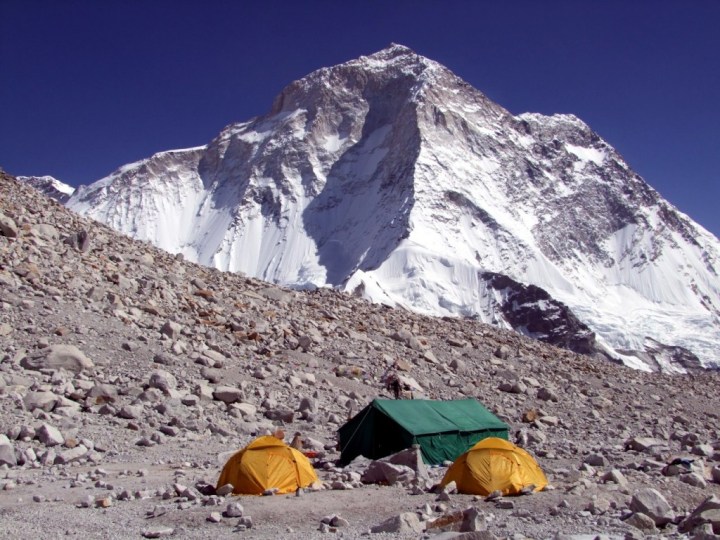The environmental cost of mountaineering expeditions
Base camp on the east side of Baruntse, Nepal, is one of the most breathtaking settings you’re ever likely to come across. Hemmed in by rock walls on two sides, to the west the fluted snout of a glacier rises high above camp like a cathedral organ carved in ice. To the east the grey rock pyramid of Makalu, the fifth highest mountain on Earth, towers above the horizon a whole three kilometres vertically overhead. It’s a place barren of vegetation, and the only signs of life are the ubiquitous choughs, mountain crows that seem to be able to fly to any altitude and find food there. Yet it’s a place where you can’t avoid feeling at one with nature, so absolutely massive and terrifying is the lump of rock that is Makalu.
You’d think anyone who arrived here would feel so privileged that they’d treat the environment with respect, but this is not the case, as the following video shows. For Baruntse base camp has suffered from successive mountaineering expeditions staying here for days as they acclimatise, creating trash, then not carrying it out again when they leave.
It wasn’t the first time I’d encountered mountaineering litter. When attempting Gasherbrum II in Pakistan in 2009, a group of us arrived at Camp 1 to see a team of Iranian mountaineers dumping several kilograms of unused food into a crevasse because they were leaving the mountain and didn’t want to carry it back down with them. The incident created a certain amount of controversy at the time because two members of our team, Arian Lemal and Michael Odell, climbed down into the crevasse, retrieved the rubbish and emptied it in front of the Iranian team as they were having dinner at base camp a couple of days later.
At the time Arian was writing a dissertation on waste management on 8000 metre peaks as part of his masters degree at the University of Christchurch, New Zealand. He interviewed expedition leaders and created quite a lot of awareness about the issue among expedition teams climbing the Gasherbrums that year. Nobody wanted to be caught out again like the Iranian team, and as they left the mountain one by one, they left food bags outside tents of other climbers as a gift, rather than dumping it into a crevasse. Presumably the last remaining team at Camp 1, faced with tons of food to carry down and only a handful of people to carry it, dumped it for them.

Dumping litter into crevasses is nothing new, and there are many people who still find nothing wrong with it. Their view is that human life is more important. Life at extreme altitudes isn’t easy and after a long summit day mountaineers are physical exhausted, and many have very little energy left to descend to safety, never mind take down a tent and carry it back with them. Getting back down alive is their priority, and how they justify collapsing their tent and food into a crevasse where no one can see it. Trash dumped in crevasses may be out of sight and out of mind, but it creates problems for future generations. As the ice slowly moves along the Baltoro Glacier, it will emerge near the village of Askole many years from now. With hundreds of climbers attempting Pakistan’s 8000 metre peaks every year, that’s an awful lot of litter getting strewn across the Karakoram.
Thankfully attitudes are now changing. Most expedition teams adopt Leave No Trace policies, and the idea of dumping uneaten food and empty packaging is seen for what it is: a desecration of the beautiful environment they are lucky to travel in. Better still, dedicated clean-up expeditions are becoming more common. We passed one of these and filmed them at Concordia near K2 when we were in the Karakoram in 2009, and on Everest such expeditions take place every year, as this short film by National Geographic shows.
Despite this, it only takes a handful of people to turn a mountain landscape into a trash heap that will probably never be made pure again. Clean-up expeditions tend to take place in the high profile destinations like Everest and K2. At Baruntse base camp I asked our sirdar Dawa how many porters he thought it would take to carry away all the rubbish we could see. He estimated more than twice as many as we had, and that was if they carried nothing else.
We made tiny inroads by burning some of the litter, but we carried away only those things we had brought up ourselves. Some would say we didn’t do enough, and they are probably right. The rest of the trash, I think, will be there for a very long time.






